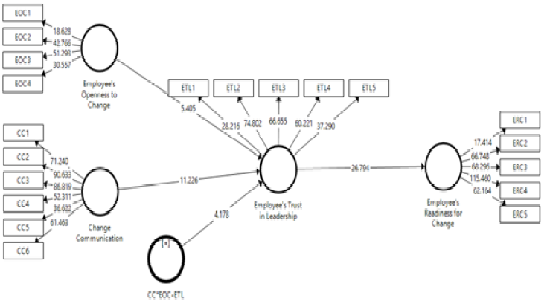


Indian Journal of Science and Technology
Year: 2020, Volume: 13, Issue: 26, Pages: 2625-2632
Original Article
Farzana Akmal Memon1*, Sobia Shah1, Imam Uddin Khoso1
11Institute of Business Administration, University of Sindh Jamshoro, Pakistan
*Corresponding Author
Email: [email protected]
Received Date:17 June 2020, Accepted Date:08 July 2020, Published Date:27 July 2020
Objective : The purpose of present study is to investigate the relationship between Change Communication and employees' readiness for change. Additionally, the study has attempted to address the mediating effect of employees trust on Change communication – employees' readiness relationship. Furthermore,the study reports the moderating effect of employees' openness on relationship between Change communication and employees trust. Method: Data collected from employees of telecommunication sector in Pakistan i.e PTCL, Ufone, Mobilink, Telenor undergoing through structural change. A two-step method to partial least square- structural equation modeling used in the study. Findings: Testing the Kurt Lewin theory of change providing empirical evidence on the hypothesized relationships found that communication was positively associated with employee readiness. However, employee trust mediates this link. The relationship between communication and trust depends on higher levels of employee openness to change. Novelty: This study will be among few studies that have highlighted the importance of change communication in developing trust by removing fears and uncertainties and making employees ready to accept the change during mergers, acquisitions and divestitures using the lens of Lewin's three-step model.
Keywords: Change communication; openness to change; trust in leadership; readiness for change
© 2020 Memon, Shah,Khoso.This is an open-access article distributed under the terms of the Creative Commons Attribution License, which permits unrestricted use, distribution, and reproduction in any medium, provided the original author and source are credited. Published By Indian Society for Education and Environment (iSee)
Subscribe now for latest articles and news.